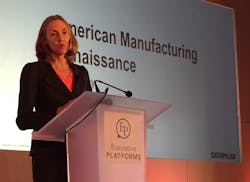Renaissance is a label that people tend to apply fairly loosely, describing a cultural rebirth of one kind or another. But with a quick history lesson on the Renaissance of the 1500s, Tana Utley, a vice president at Caterpillar, showed how developments like ubiquitous sensors, exponential machine learning, the Internet of Things (IoT), productivity and quality of life put our current era of manufacturing into a true Renaissance as well.
During the Renaissance, the privileges of the intellectual elites began to spread down to everyone. “It gave us freedom from the narrow confines defined by religion, and began to release some boundaryless creativity,” Utley said.
Life sciences, art, engineering and even architecture brought forth a number of inventions—such as reading glasses and the printing press—that had a dramatic impact on productivity and the quality of life. “Couple them together, and they had an impounding effect,” Utley noted.
Today, we see the effects of Moore’s Law—the doubling of transistors on a chip every 18 months—that has created a dramatic decrease in the cost of electronics and enables sensors everywhere. We’re getting health data from our Fitbits that previously would’ve required going to a hospital and getting fit with expensive wiring. The smartphone now acts as a router, collecting data from our devices, and feeding it back to our computers.
“We’re creating some of the same kind of conditions as the 1500s, including freedom of thought and democratizing creativity,” Utley said.
Utley’s discussion of this Renaissance through technology was the backdrop for her presentation at the North American Manufacturing Excellence Summit (NAMES) in Chicago recently, where she talked about fostering an American manufacturing renaissance.
She hit on many of the technologies that are reshaping the way manufacturing functions: RFID tags that can track work in progress; sophisticated machine learning tools that greatly reduce the amount of time needed for optimization analysis; 3D printing that not only significantly reduces the cycle time for development, but increases the number of iterations as well; along with the Internet of Things (IoT), ubiquitous data and increased compute power.
Utley also pointed to the advancement of robots, dispelling the idea that they were likely to replace all the manufacturing jobs. “It’s really hard to predict the future,” she said. “But they’re going to continue to improve the productivity and quality of life for people.”
Robots today aren’t necessarily the big industrial robots behind a fence that have been common in the past, but more collaborative robots. “We recently went out and bought a number of small robots, which are rather inexpensive, and dispersed them throughout the facility. You begin to understand the kinds of things they can do, and put them to work wherever you want,” she explained. “They are the kind that learn, and work side by side with the man. And he’s not intimidated by the robot. Rather, it’s helping him to make his job better.”
U.S. advantages
In all of this, the U.S. is particularly well positioned to take advantage of these technologies, according to Utley, who pointed to both our inventiveness and our proven ability to commercialize and get products into production. “Other countries have one or the other; not so much both,” she said.
Another strength is the fact that the U.S. has 29 percent of the world’s consumer market. “As U.S. manufacturers, we have the ability to connect—right away, very closely—with those customers,” Utley said. “Actually, we are they.”
The commercialization of inventions becomes a reality through our ability to incorporate, Utley added. “We make that come to a reality through corporations,” she said. “We invented, commercialized, formed a corporation. We still do that. We’re still inventing, commercializing, turning that into a corporation.”
The skilled workforce, however, is an area that needs to be shored up, Utley said. “80 percent of U.S. manufacturers are reporting a shortage of a skilled workforce,” she said. “I’m astounded by the number of applicants that can’t even fill out an application, or don’t have the basic skills we need.”
“We have a role in helping to solve this problem,” Utley went on, pointing to the need for more vocational education, more women in the manufacturing workforce, and paid internships. “If you’re in an industry where internships aren’t paid, make a note to self: This might be a tough slog.”
Utley also urged manufacturers toward lean programs. “We like to invent things, do things our own way,” she said, pointing to a cowboy mentality. But that doesn’t need to be at odds with a more disciplined approach. “It’s about making their jobs more productive and better, less bureaucratic. Grasp onto it. Bring American ingenuity to it as well.”
Caterpillar’s facility in Lafayette, Ind., has implemented built-in quality, with a checklist for inspectors on an iPad. “When they find one, it’s not a gotcha,” she explained. Instead, the workforce is engaged in working together to make the facility more competitive.
U.S. manufacturers gathered together in forums like NAMES can raise the collective understanding of lean. “When we come together through these forums, we’re really helping the competitiveness overall of U.S. manufacturing.”
Ultimately, Utley listed seven things that U.S. manufacturing can do to support the Renaissance:
- Innovate. “Start small, experiment, and be ready to fail.”
- Implement lean.
- Celebrate manufacturing. “Let’s not forget the people who go to work every day. Make them heroes.”
- Promote manufacturing careers, whether through schools, internship or other means.
- Get involved with academia.
- Promote and support collaborative partnerships—with academia, industry and government.
- Advocate for the ecosystem. Speak out on infrastructure, regulations or tax infrastructure.

